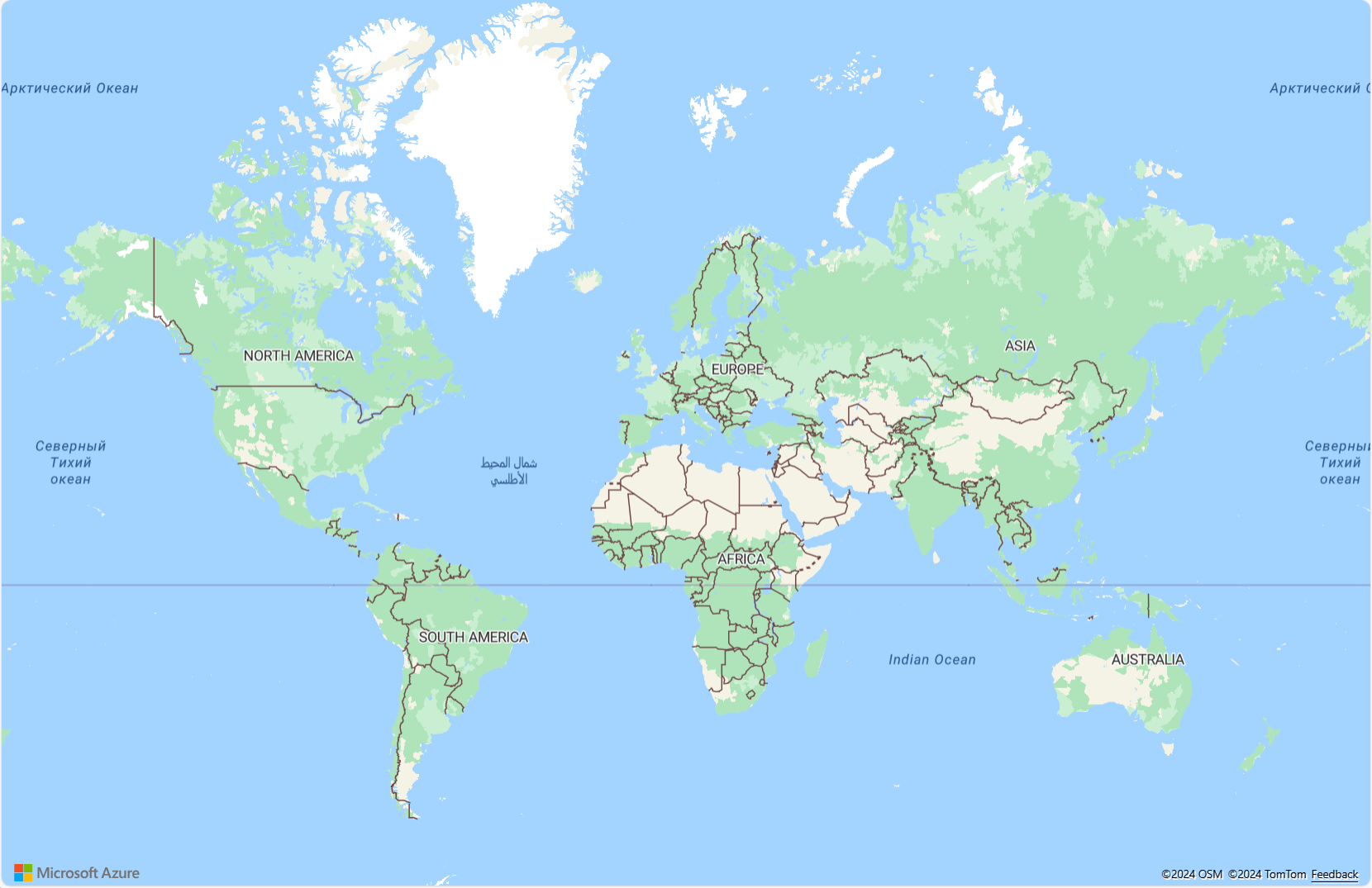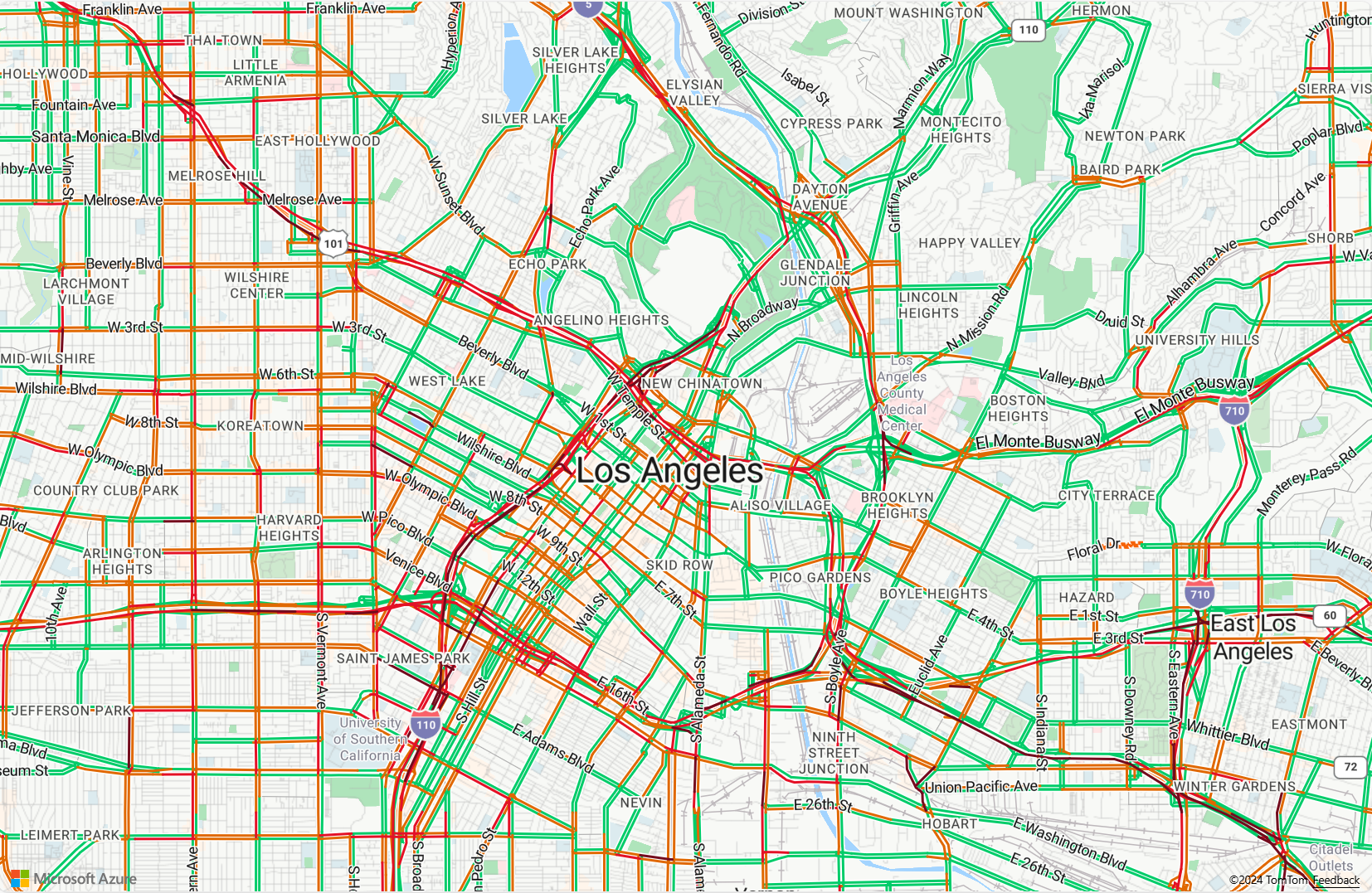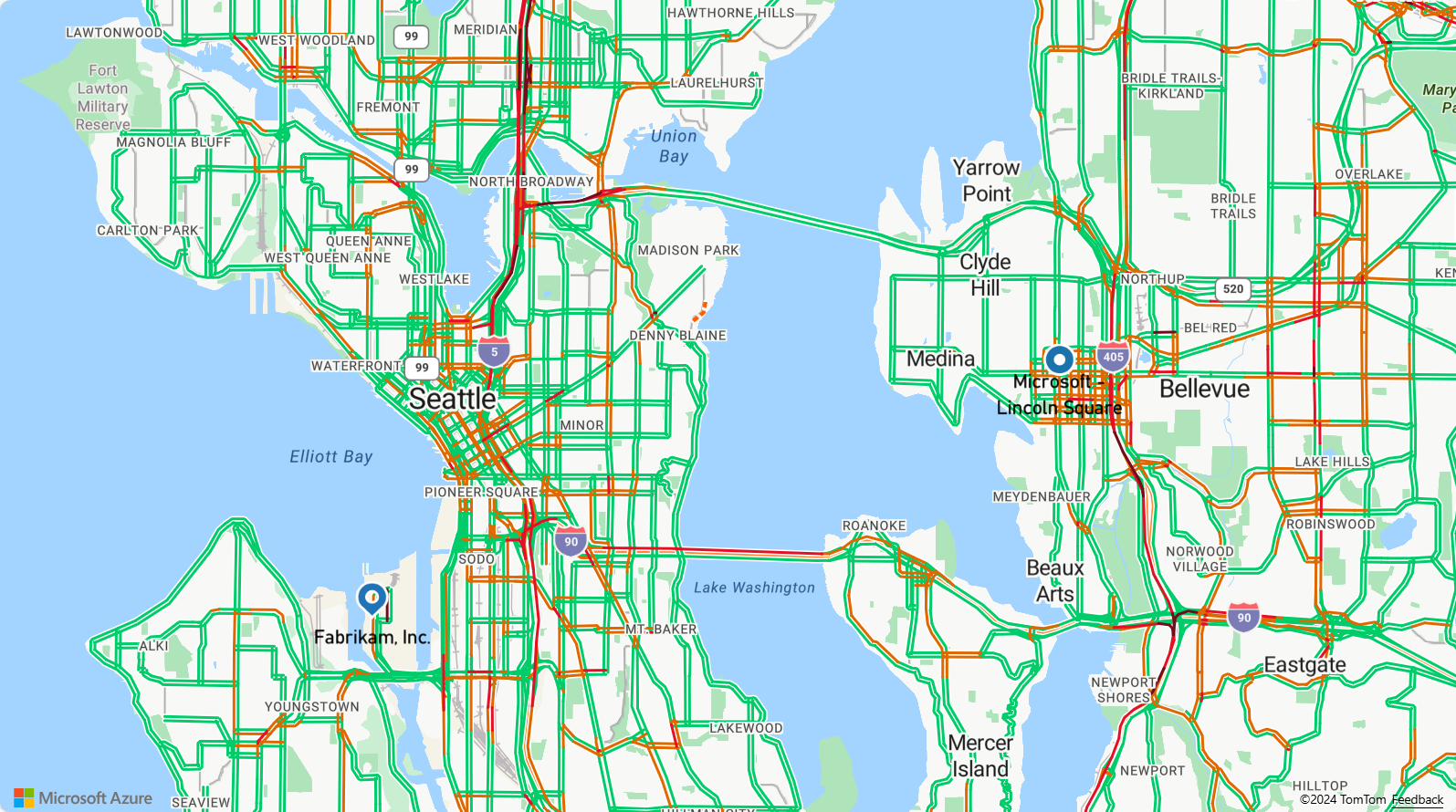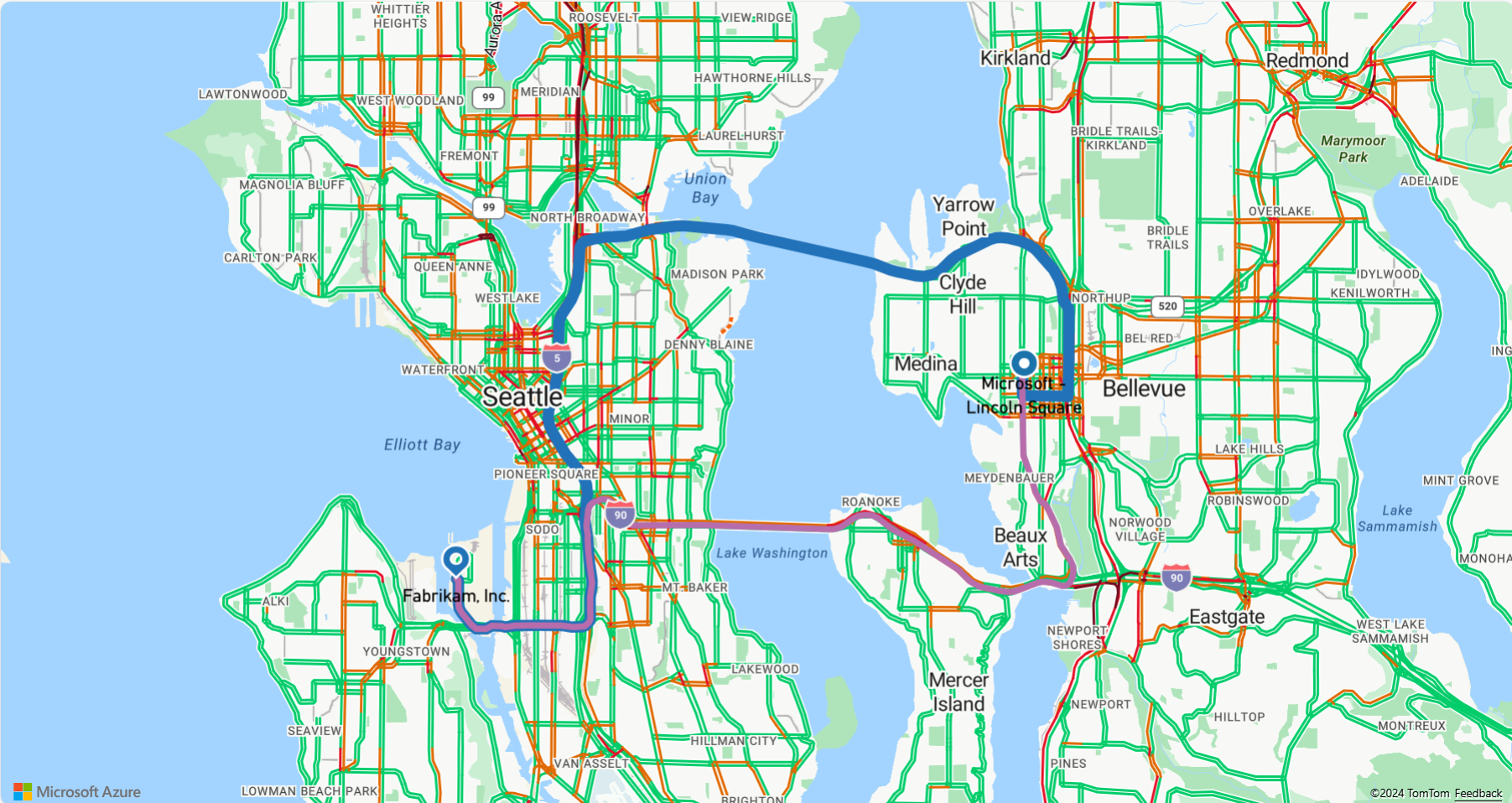Tutorial: Find and display routes for different modes of travel using Azure Maps
This tutorial demonstrates how to use the Azure Maps Route service and Map control to display route directions for both private vehicles and commercial vehicles (trucks) with USHazmatClass2 cargo type.
In this tutorial, you learn how to:
- Create and display the Map control on a web page
- Render real-time traffic data on a map
- Request and display private and commercial vehicle routes on a map
Prerequisites
Note
For more information on authentication in Azure Maps, see manage authentication in Azure Maps.
Create a new web page using the map control API
The following steps show you how to create and display the Map control in a web page.
On your local machine, create a new file and name it MapTruckRoute.html.
Add the following HTML to the file:
<!DOCTYPE html> <html> <head> <title>Map Route</title> <meta charset="utf-8"> <meta name="viewport" content="width=device-width, initial-scale=1, shrink-to-fit=no"> <!-- Add references to the Azure Maps Map control JavaScript and CSS files. --> <link rel="stylesheet" href="https://atlas.microsoft.com/sdk/javascript/mapcontrol/3/atlas.min.css" type="text/css"> <script src="https://atlas.microsoft.com/sdk/javascript/mapcontrol/3/atlas.min.js"></script> <script> var map, datasource, client; function GetMap() { //Add Map Control JavaScript code here. } </script> <style> html, body { width: 100%; height: 100%; padding: 0; margin: 0; } #myMap { width: 100%; height: 100%; } </style> </head> <body onload="GetMap()"> <div id="myMap"></div> </body> </html>Some things to know about the HTML:
- The HTML header includes CSS and JavaScript resource files hosted by the Azure Map Control library.
- The
onloadevent in the body of the page calls theGetMapfunction when the body of the page finishes loading. - The
GetMapfunction contains the inline JavaScript code used to access the Azure Maps API.
Next, add the following JavaScript code to the
GetMapfunction, just beneath the code added in the last step. This code creates a map control and initializes it using your Azure Maps subscription keys that you provide. Make sure and replace the string<Your Azure Maps Subscription Key>with the Azure Maps subscription key that you copied from your Maps account.//Instantiate a map object var map = new atlas.Map("myMap", { // Replace <Your Azure Maps Subscription Key> with your Azure Maps subscription key. https://aka.ms/am-primaryKey authOptions: { authType: 'subscriptionKey', subscriptionKey: '<Your Azure Maps Subscription Key>' } });Some things to know about the JavaScript:
Save the file and open it in your browser. The browser displays a basic map by calling
atlas.Mapusing your Azure Maps subscription key.
Render real-time traffic data on a map
In the
GetMapfunction, after initializing the map, add the following JavaScript code. This code implements the Map control'sreadyevent handler.map.events.add("ready", function() { // Add Traffic Flow to the Map map.setTraffic({ flow: "relative" }); });Some things to know about the JavaScript:
- This code implements the Map control's
readyevent handler. The rest of the code in this tutorial is placed inside thereadyevent handler. - In the map
readyevent handler, the traffic flow setting on the map is set torelative, which is the speed of the road relative to free-flow. - For more traffic options, see TrafficOptions interface.
- This code implements the Map control's
Save the MapTruckRoute.html file and refresh the page in your browser. If you zoom into any city, like Los Angeles, the streets display with current traffic flow data.
Define route display rendering
In this tutorial, two routes are calculated on the map. The first route is calculated for a private vehicle (car). The second route is calculated for a commercial vehicle (truck) to show the difference between the results. When rendered, the map displays a symbol icon for the start and end points of the route, and route line geometries with different colors for each route path. For more information on adding line layers, see Add a line layer to a map. To learn more about symbol layers, see Add a symbol layer to a map.
In the Map control's
readyevent handler, append the following code.//Create a data source and add it to the map. datasource = new atlas.source.DataSource(); map.sources.add(datasource); //Add a layer for rendering the route lines and have it render under the map labels. map.layers.add(new atlas.layer.LineLayer(datasource, null, { strokeColor: ['get', 'strokeColor'], strokeWidth: ['get', 'strokeWidth'], lineJoin: 'round', lineCap: 'round' }), 'labels'); //Add a layer for rendering point data. map.layers.add(new atlas.layer.SymbolLayer(datasource, null, { iconOptions: { image: ['get', 'icon'], allowOverlap: true }, textOptions: { textField: ['get', 'title'], offset: [0, 1.2] }, filter: ['any', ['==', ['geometry-type'], 'Point'], ['==', ['geometry-type'], 'MultiPoint']] //Only render Point or MultiPoints in this layer. }));Some things to know about the JavaScript:
- In the Map control's
readyevent handler, a data source is created to store the route from start to finish. - Expressions are used to retrieve the line width and color from properties on the route line feature.
- To ensure that the route line doesn't cover up the road labels, pass a second parameter with the value of
'labels'.
Next, a symbol layer is created and attached to the data source. This layer specifies how the start and end points are rendered. Expressions are added to retrieve the icon image and text label information from properties on each point object. To learn more about expressions, see Data-driven style expressions.
- In the Map control's
Next, set the start point as a fictitious company in Seattle called Fabrikam, and the end point as a Microsoft office. In the Map control's
readyevent handler, append the following code.//Create the GeoJSON objects which represent the start and end point of the route. var startPoint = new atlas.data.Feature(new atlas.data.Point([-122.356099, 47.580045]), { title: 'Fabrikam, Inc.', icon: 'pin-blue' }); var endPoint = new atlas.data.Feature(new atlas.data.Point([-122.201164, 47.616940]), { title: 'Microsoft - Lincoln Square', icon: 'pin-round-blue' }); //Add the data to the data source. datasource.add([startPoint, endPoint]); //Fit the map window to the bounding box defined by the start and end positions. map.setCamera({ bounds: atlas.data.BoundingBox.fromData([startPoint, endPoint]), padding: 100 });About the JavaScript:
- This code creates two GeoJSON Point objects to represent start and end points, which are then added to the data source.
- The last block of code sets the camera view using the latitude and longitude of the start and end points.
- The start and end points are added to the data source.
- The bounding box for the start and end points is calculated using the
atlas.data.BoundingBox.fromDatafunction. This bounding box is used to set the map cameras view over the entire route using themap.setCamerafunction. - Padding is added to compensate for the pixel dimensions of the symbol icons.
- For more information, see the setCamera function in the Microsoft technical documentation.
Save TruckRoute.html and refresh your browser. The map is now centered over Seattle. The blue teardrop pin marks the start point. The round blue pin marks the end point.
Request and display private and commercial vehicle routes on a map
This section shows you how to use the Azure Maps Route service to get directions from one point to another, based on your mode of transport. Two modes of transport are used: truck and car.
Tip
The Route service provides APIs to plan fastest, shortest, eco, or thrilling routes based on distance, traffic conditions, and mode of transport used. The service also lets users plan future routes based on historical traffic conditions. Users can see the prediction of route durations for any given time. For more information, see Get Route directions API.
In the
GetMapfunction, inside the control'sreadyevent handler, add the following JavaScript code to construct a truck route from the start to end points. This route is created and displayed for a truck carryingUSHazmatClass2classed cargo.//Start and end point input to the search route request var query = startPoint.geometry.coordinates[1] + "," + startPoint.geometry.coordinates[0] + ":" + endPoint.geometry.coordinates[1] + "," + endPoint.geometry.coordinates[0]; //Make a search route request for a truck vehicle type var truckRouteUrl = `https://atlas.microsoft.com/route/directions/json?api-version=1.0&travelMode=truck&vehicleWidth=2&vehicleHeight=2&vehicleLength=5&vehicleLoadType=USHazmatClass2&query=${query}`; fetch(truckRouteUrl, { headers: { "Subscription-Key": map.authentication.getToken() } }) .then((response) => response.json()) .then((response) => { var route = response.routes[0]; //Create an array to store the coordinates of each turn var routeCoordinates = []; route.legs.forEach((leg) => { var legCoordinates = leg.points.map((point) => { return [point.longitude, point.latitude]; }); //Add each turn to the array routeCoordinates = routeCoordinates.concat(legCoordinates); }); //Add the route line to the data source. We want this to render below the car route which will likely be added to the data source faster, so insert it at index 0. datasource.add( new atlas.data.Feature(new atlas.data.LineString(routeCoordinates), { strokeColor: "#2272B9", strokeWidth: 9 }), 0 ); });About the above JavaScript:
- This code queries the Azure Maps Route service through the Azure Maps Route Directions API.
- The route line is then created from the coordinates of each turn from the response.
- The route line is then added to the data source.
- Two properties are added to the truck route line: a blue stroke color
#2272B9, and a stroke width of nine pixels. - The route line is given an index of 0 to ensure that the truck route is rendered before any other lines in the data source. The reason is the truck route calculation are often slower than a car route calculation. If the truck route line is added to the data source after the car route, it will render above it.
Tip
To see all possible options and values for the Azure Maps Route Directions API, see URI Parameters for Post Route Directions.
Next, append the following JavaScript code to create a route for a car.
var carRouteUrl = `https://atlas.microsoft.com/route/directions/json?api-version=1.0&query=${query}`; fetch(carRouteUrl, { headers: { "Subscription-Key": map.authentication.getToken() } }) .then((response) => response.json()) .then((response) => { var route = response.routes[0]; //Create an array to store the coordinates of each turn var routeCoordinates = []; route.legs.forEach((leg) => { var legCoordinates = leg.points.map((point) => { return [point.longitude, point.latitude]; }); //Add each turn to the array routeCoordinates = routeCoordinates.concat(legCoordinates); }); //Add the route line to the data source. This will add the car route after the truck route. datasource.add( new atlas.data.Feature(new atlas.data.LineString(routeCoordinates), { strokeColor: "#B76DAB", strokeWidth: 5 }) ); });About the JavaScript:
- This code queries the Azure Maps routing service through the Azure Maps Route Directions API method.
- The route line is then created from the coordinates of each turn and added to the data source.
- Two properties are added to the truck route line: a purple stroke color
#B76DAB, and a stroke width of five pixels.
Save the TruckRoute.html file and refresh your web browser. The map should now display both the truck and car routes.
- The truck route is displayed using a thick blue line and the car route is displayed using a thin purple line.
- The car route goes across Lake Washington via I-90, passing through tunnels beneath residential areas. Because the tunnels are in residential areas, hazardous waste cargo is restricted. The truck route, which specifies a
USHazmatClass2cargo type, is directed to use a different route that doesn't have this restriction.
- For the completed code used in this tutorial, see the Truck Route tutorial on GitHub.
- To view this sample live, see Multiple routes by mode of travel on the Azure Maps Code Samples site.
- You can also use Data-driven style expressions.
Next steps
The next tutorial demonstrates the process of creating a simple store locator using Azure Maps.



